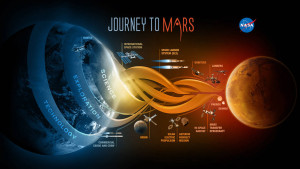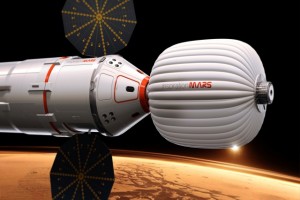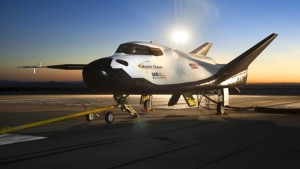By Chad Pillai.
Two years ago, I wrote that our Space Program has taken a Giant Leap Backwards because it seemed ill defined and lost the pioneering spirit we had in the 1960s. However, the past 90 days represents both a rebirth of the U.S. Space Program and a passing of the guard between the old and new pioneers. The recent passing of the Starman, British rocker, David Bowie, whose song “Space Oddity” was released as a single 5 days prior to the Apollo 11 Moon mission, a mission that captivated the world and promised even greater exploration, represents the old guard. Unfortunately, as I’ve stated, our moon program didn’t go any further and NASA returned its focus towards low earth orbit utilizing the now retired Space Shuttle and now requiring Russian launch support to the International Space Station (ISS). While it has been 37 years since the U.S. landed astronauts on moon, the U.S. Space Program is entering a new phase driven by competition from the likes of Russia, China, and India to return to the moon and beyond, and also as a result of pioneering efforts by commercial space entrepreneurs such as Elon Musk (SpaceX) and Jeff Bezos (Blue Origin). The Commercial Space Program
The last few years has seen the growth of the commercial space program with the rise of companies such as SpaceX, Blue Origin, Orbital Sciences, Virgin Galactic, and Sierra Nevada Corporation competing for NASA contracts to resupply the ISS and provide the means to launch U.S. astronauts into orbit without the assistance of the Russians. The crown jewel for the commercial long-term viability of the program was established by SpaceX when it sought to achieve what NASA failed to do since its inception: develop cheap and reliable reusable rockets. On December 21, 2015, SpaceX successfully launched its payload and recovered its Falcon 9 rocket. However, while Blue Origin’s New Shepard successfully demonstrated this feat first on November 23, 2015, it must be noted that the specifications of the two types of rockets and launch parameters were different. However, what is important is that both companies have demonstrated the feasibility of reusable rockets which will further reduce the costs of future missions. The addition of the reusable space plane (Dream Chaser) will provide additional benefits to the sector as well. Virgin Galactic is taking a different approach by focusing on developing commercial sub-orbital space flight for space tourists, and could be a game changer in future global travel that will either force today’s commercial airlines to go out of business or force them to adapt. To make commercial development of space, Congress passed and the President signed into law the U.S. Commercial Space Launch Competitiveness Act (H.R. 2262) on November 25, 2015. This will provide an incentive for commercial enterprises to invest and permanently settle the Moon and asteroids. Mars and Beyond  The commercial program allows NASA to focus on its core mission of deep space exploration. NASA’s next major goal is a manned mission to Mars. In fact, Congress recently authorized NASA to spend $55 million to build a Mars Habitat to support such a mission. NASA has advertised its Mars One program looking for applicants to not only make the journey, but for some, to remain permanently. The mission to mars will be made using NASA’s new Space Launch System (SLS) propelling its Orion Capsule. To achieve this feat, NASA has laid out a three phase plan that will seek to land humans on the surface of Mars in the 2030s. If successful, my generation and my children’s generation will be alive to witness the same scientific accomplishment and wonderment my parents and grandparents felt when they watched Neil Armstrong set foot on the surface of the moon. NASA is not limiting itself to getting a manned mission to Mars, but is focusing on extending its knowledge of deep space. Its New Horizons program is intended to explore the Pluto System and the Kuiper Belt. As it reaches deeper into space, it will open new possibilities for human exploration and tap into unknown economic opportunities. Conclusion The Intertwining of the Commercial Space Program and NASA’s refocus on deep space exploration allows the U.S. to tap back into its pioneering spirit. Competition and cooperation with other Space Powers such as Russia, China, Japan, India, and the European Space Agency will further our knowledge of the universe and usher in a new period of discovery not seen since the “Age of Sail” in the 1400s. This new pioneering spirit is being led by the Starman, Major Tom, transcending time and space as he passes from our galaxy to one far beyond. http://www.digitaltrends.com/cool-tech/congress-spending-bill-urges-nasa-to-develop-deep-space-habitat/ (Picture of Habitat)
The commercial program allows NASA to focus on its core mission of deep space exploration. NASA’s next major goal is a manned mission to Mars. In fact, Congress recently authorized NASA to spend $55 million to build a Mars Habitat to support such a mission. NASA has advertised its Mars One program looking for applicants to not only make the journey, but for some, to remain permanently. The mission to mars will be made using NASA’s new Space Launch System (SLS) propelling its Orion Capsule. To achieve this feat, NASA has laid out a three phase plan that will seek to land humans on the surface of Mars in the 2030s. If successful, my generation and my children’s generation will be alive to witness the same scientific accomplishment and wonderment my parents and grandparents felt when they watched Neil Armstrong set foot on the surface of the moon. NASA is not limiting itself to getting a manned mission to Mars, but is focusing on extending its knowledge of deep space. Its New Horizons program is intended to explore the Pluto System and the Kuiper Belt. As it reaches deeper into space, it will open new possibilities for human exploration and tap into unknown economic opportunities. Conclusion The Intertwining of the Commercial Space Program and NASA’s refocus on deep space exploration allows the U.S. to tap back into its pioneering spirit. Competition and cooperation with other Space Powers such as Russia, China, Japan, India, and the European Space Agency will further our knowledge of the universe and usher in a new period of discovery not seen since the “Age of Sail” in the 1400s. This new pioneering spirit is being led by the Starman, Major Tom, transcending time and space as he passes from our galaxy to one far beyond. http://www.digitaltrends.com/cool-tech/congress-spending-bill-urges-nasa-to-develop-deep-space-habitat/ (Picture of Habitat)




